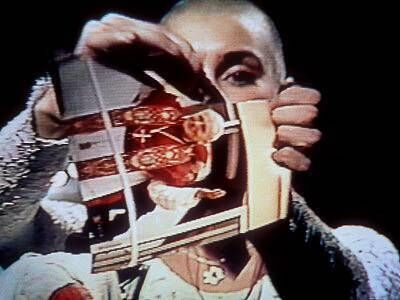Joe McNamee: Sinéad's courage gave voice to my own story of abuse

Sinéad O'Connor was not ‘fragile’, she had the courage and strength of a lioness. Picture: Maria Bastone / AFP
A close friend rang, obviously distressed.
I braced for bad news, presuming it was personal.
“Sinéad O’Connor is dead,” she said.
So, it wasn’t personal after all.
Yet it was, it was deeply personal; shock and an immediate sense of loss washed over me.
Sinéad O'Connor was not a close friend of mine. Actually, I didn’t know her at all, never even met her, even in my time as an arts writer and editor.
My relationship with her was infinitely more simple, like so many others — I was a fan.
Music has always been a fundamental cornerstone, a crucial part of my daily life — I am a ‘fan’ of many, many musical artists.
But with Sinéad, it went deeper: I was a fan of the consummately gifted and sublimely talented artist, but I was an even greater fan of Sinéad, the human being.

On first learning of a death, of a passing that leaves us in shock and causes pain it is a near-universal instinct to seek out others, to share that hurt and, equally, to understand what happened, that some fresh, new knowledge might counter the overwhelming disbelief, might make some sense of what appears in that time to be entirely senseless.
Other than to her family and close friends, Sinéad’s death existed on a different plane for the rest of us, not the same as losing a parent, a child, a sibling, or someone similarly close, but her passing revealed just how deeply treasured she was, especially in Ireland — and the pain was palpable.
In times gone by, we might have gathered in clusters over garden gates or at street corners or taken to doing the rounds on the phone, but two decades into the 21st century, the only place for such a communal and spontaneous outpouring of genuine shock, grief, and heartfelt emotion is online.
With the public news barely an hour old, there were already thousands of online posts and comments, both from ordinary people and many public figures from the world of the arts and beyond, all expressing the same keen sense of sadness and loss.
But gradually I began to register a certain slant to many of these undoubtedly well-meaning, utterly sincere, and heartfelt expressions of sympathy, an angle that might well be summed up as (using words from actual online posts): a "deeply troubled soul" "was finally at peace".
As is the way of these things, once you register something for the first time, it becomes hard to avoid seeing it everywhere. The themes emerged.
Sinéad was "fragile".
"She had her demons."
"Hope she finds peace."
"Tortured Soul."
"Her torment is over."
"A lost, sad soul, had an awful life."
Pertinently, none of those who actually knew her in person, including many musicians who had worked with her, remotely took this tack, instead praising her to the high heavens for her mercurial talents, her warm personality, and expressing deep sadness at her loss.
But you can’t blame those ordinary punters for well-meaning, if misguided, expressions of pity. After all, that is largely a result of the prurient narrative that was purveyed throughout her career by a male-dominated global media about the life of Sinéad O’Connor, that she was — in one of the most extreme expressions, equal parts glib and grotesque, described by a music journalist (yes, male) in in 2021 — the "crazy lady in pop’s attic".
The news reports and obituaries followed, too many cleaving to the same formula, the tabloid version delivered in an additional lachrymose syrup of faux sympathy: she did a nice job of that Prince song, but then blew it, and her subsequent life was pockmarked by regular and ongoing public controversies and personal crises.
Her talents, in death, as they were so often in life, were largely relegated to the status of an afterthought.
Then again, that is how a patriarchal society has long operated when confronted by strong, challenging, ‘difficult’ women: neuter the challenge by denigrating or patronising talent and ability.
And it all felt so, so wrong.
Sinéad was not ‘naive’ or ‘foolish’, or ‘fragile’.
Sinéad possessed the infinite wisdom to recognise from the beginning the pitfalls and perils of the stardom for which she was once groomed.
Even if many in her camp in those early days were well-intentioned, they were equally aware of what the pursuit of global fame and riches entailed in terms of compromise — and Sinéad never really did compromise.
It was early apparent to her that fame’s trappings were instead traps.
Sinéad O’Connor was not ‘fragile’.
To publicly acknowledge her mental health issues and to, as she often did, expose her betimes raw, pain-seared heart to the world, took enormous courage and fortitude, even more so when it earned her such public castigation and ridicule.
Yet her revelations began some of the very first public conversations about mental health and wellbeing — even if initially still linked to the folly and embarrassment of speaking of such things in public — and, nowadays, similar revelations are almost commonplace, so much of the stigma around speaking about mental illness has been removed.
Did she go too far?
That same friend who rang me with news of Sinéad’s death was never done throughout Sinéad’s life ringing me with the latest news of what she’d "got up to now".
“She’s after becoming a priest, she’s dressing as a priest! Come on, even you’ve got to admit that’s mad!”
My first reaction to that particular one was to ask: "Who is she hurting?".
The second was to ask what is so ‘mad’ about that, when men have been putting on ‘dresses’ and parading around on ’stages' for 2,000 years; why not afford women a share of that limelight?
As an atheist, I may not have shared Sinéad’s faith, but I admired her commitment to it, and endless quest for new paths to enlightenment — and, again, I’d repeat, who was she hurting?
Sinéad possessed infinite integrity, a searing conscience that was such a part of her DNA, it was impossible for her to compromise her beliefs and ideals in the pursuit of the aforementioned fame.
A natural-born activist, throughout her career she readily lent herself to campaigns and causes.
So what, many pop stars have done similar? Well, yes, but pretty much all other ‘activist’ pop crusaders set themselves up as pop stars first, ensuring stardom was achieved before finding their causes.
Some artists are gifted songwriters. Some are brilliant interpreters of the music of others. She could do both.
Even more, she was a quite beautiful young woman with an astonishing voice that belied her elfin frame — and she had sublime taste in music, a prerequisite for the great producer she was.
In other words, she was headed straight for the top. And then she tore up the pope’s photo on .

You’ll have read by now endless accounts of the worldwide public opprobrium and media castigation that followed her most notorious action, but there was also a silent cohort who were entirely in agreement with her stated intentions — the many thousands of men and women around the world, and especially in Ireland, who were once the child victims of clerical sexual and physical abuse.
This cohort remained silent because that is what those then-voiceless victims did.
It would be another few years before public reports, then trials and convictions of priests and brothers began, first a trickle, then a deluge, but when Sinéad tore up that photo, it was the first major public expression of support anywhere in the world for the victims of abuse, and it meant so, so much to those thousands still suffering in silence.
I was one of those victims, abused for the entirety of my time in 5th class in primary school, starting when I was 10 years old.
It was an open secret in the playground that Brother X was an abuser, so commonly shared that I now find it hard to believe the other brothers and lay teachers didn’t know.
But that schoolyard was a reflection of society at the time — it was a typically ‘Irish secret’ — widely known, but never spoken of in public.
The central pillars of Irish society — social, judicial, educational, political etc — reflected that secrecy and even policed it on behalf of the all-powerful Catholic Church that still presided over all.
When Sinéad tore up the photo, some of the greatest venom issued forth from Irish guardians of that society.
When I saw the footage, I too felt anger, even rage, but as if granted permission to do so, for what had been done to me as a child.
I felt sorrow for that child and I felt deep gratitude to Sinéad, for what she had said, for the sacrifice she made — and it was a sacrifice.
It was the beginning of me speaking openly about the abuse to family and friends, and eventually people I didn’t know all that well.
Each time I spoke, it further loosened a psychic vice and, so often, prompted others to share their stories, of mental health struggles or emotional issues, sometimes even of abuse.
I believe it is hugely important, even life-saving, to be able to speak about these things. I now speak of them very openly and honestly.
However, until the day Sinead died, I never used whatever public forum I have as a writer and journalist to speak of that abuse, it was part of my ‘private’ life.
Then as I read over and over again of this poor ‘fragile creature, at peace now’, I felt compelled by the need to stand up for her as I felt she once did for me and many thousands more.
I posted a tweet, I referenced my own abuse, and wrote that Sinead had been an ‘inspiration to me’.
It was brought to the attention of my editor who asked me — with great sensitivity and kindness—to write this article expanding on the themes of the Tweet, revealing or concealing as much or as little about the abuse reference as I wished.
I started writing.
It began easily but became more and more difficult towards the end, professional becoming increasingly personal. And I felt so much fear.
I still do, even more so at the thought of it being published, the feeling of being naked, exposed.
But I thought of the woman I was writing about and the courage with which she faced and fought her own fears, of how she recognised that there is healing to be found in the act of exposing, of baring the wound, and I found something resembling the necessary steel.
Sinead O’Connor was truly a great artist and I firmly believe, had she lived, would have received the breadth of recognition she so thoroughly deserved, judged by a true yardstick, the quality of her body of work, not by the shallow gauge of public fame.
But, more so again, she was an incredible human being who rarely shied away from life, instead engaging it with integrity, courage, honesty, humour, vitality, passion, pain, hurt, and, most of all, love.
My tweet ended as follows: “... great warriors don't win every battle, but in a country with a mythic tradition of female warriors, she was the greatest of them all, and Sinead so very definitely won the war.”
- If you are affected by any of the issues raised in this article, please click here for a list of support services.
















